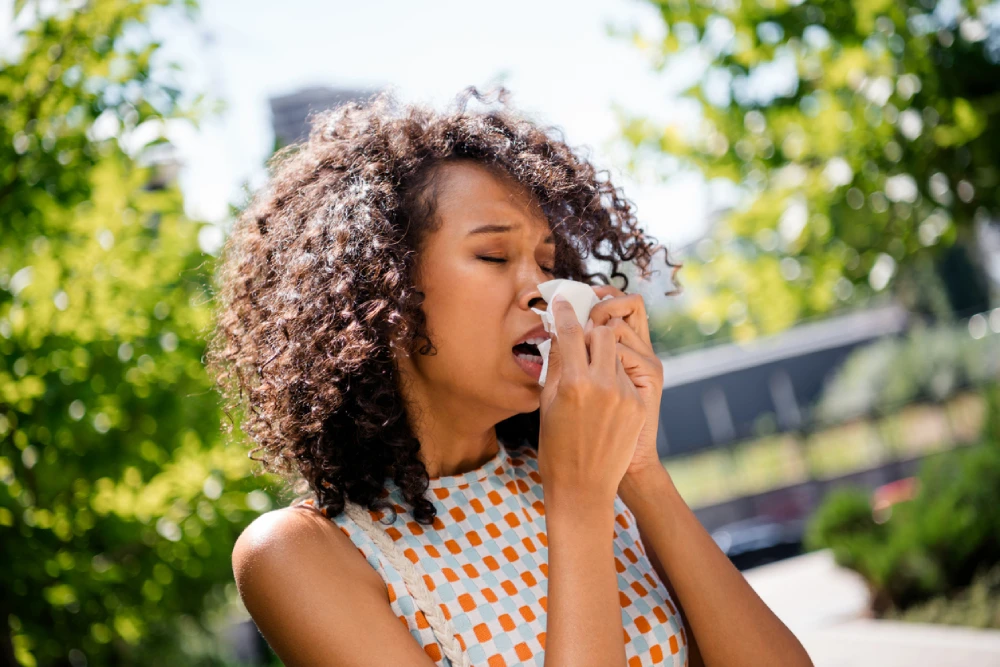Late summer in Canada might be beautiful, but it can also feel like allergy season is in full force. From August through early October, seasonal allergies tend to peak.
Ragweed, one of the most common seasonal allergens according to the Ontario Blue Cross, thrive during this period, releasing pollen into the air, which, for many, often results in an uptick in symptoms.
This can lead to sneezing fits, itchy eyes, and general discomfort that can interfere with your daily life.
If you’ve noticed your symptoms take a turn for the worse in late summer, you’re not alone, and you’re not without options.
In this guide, we’ll walk you through how allergies are diagnosed, explain what makes late summer unique, and share eight practical tips to relieve your symptoms.
How Allergies Are Diagnosed
Before you can treat seasonal allergies effectively, it’s essential to understand what you’re dealing with. Seasonal allergies often look similar to colds or respiratory infections, so getting a proper diagnosis is key.
Allergy symptoms
Seasonal allergy symptoms typically appear when your immune system overreacts to airborne allergens like pollen or mold. The most common signs include:
- Sneezing, often in rapid succession
- Nasal congestion and sinus pressure
- Itchy, watery, or red eyes
- Itchy throat or ears
- Coughing or postnasal drip
- Ear fullness or popping sensations
These symptoms tend to fluctuate with changes in weather, outdoor activity, and pollen counts. They often worsen in the morning or after being outdoors.
Allergy testing
If symptoms persist or are interfering with your quality of life, your healthcare provider or allergist may recommend testing. Common diagnostic tests include:
- Skin prick testing: Small amounts of allergens are introduced on the skin to observe reactions.
- Blood tests: These measure allergen-specific antibodies, especially when skin testing isn’t possible.
Once your triggers are identified, you can move toward an effective personalized allergy treatment plan, one that includes both avoidance strategies and medication.
8 Ways To Relieve Summer Allergy Symptoms
When it comes to managing seasonal allergies in summer, taking a multi-layered approach is the most effective. Below are eight proven strategies you can start using right away.
1. Know Your Triggers: Late-Summer Allergens
Understanding what causes your seasonal allergies is the first and most important step toward effective relief. Many people mistakenly think of spring as the peak of allergy season, but late summer can be even more problematic, especially in many parts of Canada.
- Grass pollen: Levels remain high through August, particularly from species like Timothy and Kentucky bluegrass. These pollens easily stick to skin, clothing, and pet fur, entering your home even if you haven’t spent much time outside.
- Ragweed pollen: One of the most aggressive late-summer allergens, ragweed begins to bloom around mid-August and peaks in September, making it a major culprit for allergy flare-ups during this time.
- Outdoor molds: These tend to flourish in warm, damp conditions and can be found in soil, compost piles, and rotting vegetation. Because late summer often brings increased humidity and decaying plant matter, mold exposure can spike.
- Indoor allergens: Often become more problematic as people begin closing windows at night. Dust mites thrive in bedding and upholstered furniture, while pet dander can increase in enclosed environments.
Knowing your personal triggers through allergy testing can help you focus your efforts where they matter most. Once you know what’s bothering you, you can plan your outdoor activities, cleaning routines, and medication schedule accordingly.
2. Monitor Pollen Counts Proactively
To actively manage your symptoms day to day, checking daily pollen forecasts can help you avoid peak exposure times and reduce triggers. Here are some things to consider:
- Pollen is typically highest in the early morning (5 AM – 10 AM). Apps like The Weather Network can help you plan your day.
- If possible, plan workouts or yard work for late afternoon, wear a mask outdoors, or simply keep indoor days when counts are high.
Being proactive helps you avoid unnecessary exposure and manage symptoms before they start.
3. Protection for Outdoor & Yard Management
Whether it’s cutting grass, tending to your garden, or simply spending an afternoon outside, allergies can quickly leave you retreating to the indoors.
Luckily, with a few smart adjustments, you can reduce the amount of irritants you come into contact with and minimize your allergy symptoms:
- Mow safely: Wear a mask when mowing the lawn and keep grass trimmed short to reduce pollen production.
- Choose low-pollen landscaping: Consider switching to hardscape elements like stone, mulch, or sand where possible instead of high-pollen grasses or trees.
- Manage pet exposure: Pollen clings to fur. Wipe down your pet’s paws and coat after walks or outdoor play, and consider frequent baths.
Taking a few simple precautions outdoors can make a huge difference in your symptom severity.
4. Allergy-proofing Your Home
Your home should be your safe zone from allergens, but without the right precautions, it can easily become a hidden source of symptoms. Taking steps to allergy-proof your environment is one of the most effective ways to find lasting relief.
Improve air quality and circulation:
- Keep windows closed on high pollen days, especially in the morning and early afternoon when levels are at their peak.
- Use HEPA filters in your furnace and vacuum cleaner to trap fine particles like pollen, dust, and mold spores.
- Run your air conditioner with clean filters to cool the home without letting allergens in.
Focus your cleaning on high-impact zones:
- The bedroom is particularly important, since we spend nearly a third of our day there. Use allergen-proof covers on mattresses and pillows.
- Dust hard surfaces with a damp cloth instead of dry dusting, which can spread allergens into the air.
- Clean bathroom tiles, showers, and around sinks frequently to prevent mold buildup, especially in humid climates.
Control indoor humidity:
- Keep humidity levels under 50 percent using a dehumidifier. Mold and dust mites both thrive in damp air.
- Empty and clean dehumidifier reservoirs regularly to prevent bacteria and mold accumulation.
Manage fabrics and soft materials:
- Wash bedding, curtains, and throw blankets weekly in hot water (at least 60°C) to kill dust mites.
- Limit wall-to-wall carpeting, which can trap pollen and dust. Use washable area rugs instead.
Making these environmental changes helps limit your contact with allergens and reduces the load on your immune system, allowing your medications to work more effectively.
5. Personal Hygiene & Daily Habits
Even if you’re taking medication, your daily habits can either make or break your allergy control. Simple hygiene practices and lifestyle adjustments help prevent allergens from entering your body or lingering on your skin and in your home.
After being outdoors:
- Always shower and change clothes when you come inside. Pollen and mold spores cling to your skin and clothing, so rinsing off reduces the amount you bring into your living space.
- Avoid placing outdoor-worn clothes on beds or furniture. Instead, toss them directly into the laundry.
Clothing management:
- Wash outdoor clothes in hot water to eliminate pollen. Avoid hanging laundry to dry outside during peak pollen periods, as clothes can collect allergens from the air.
- Choose smooth fabrics over fuzzy materials like fleece, which can trap allergens more easily.
Face and hand hygiene:
- Wash your hands and face frequently, especially after walking outside, gardening, or petting animals.
- Avoid rubbing your eyes or touching your nose, which can transfer pollen and cause irritation.
Adjust outdoor behaviours:
- Wear sunglasses to shield your eyes from airborne pollen.
- Cover your hair with a hat, especially on windy days.
- Limit time outdoors during peak pollen hours (early morning and dry, breezy afternoons).
These routines might seem small, but together they can make a noticeable difference in your allergy symptoms.

6. Pharmacological Relief: Over-The-Counter Medications For Seasonal Allergies
When lifestyle changes are not enough, over-the-counter medications are often the first line of defence. Here are a few of the most common treatment options.
- Antihistamines: Cetirizine and Loratadine are the most commonly used medications, offering extended, daily relief for allergy symptoms with minimal side effects. They work by blocking histamine, the chemical your immune system releases during an allergic reaction. For affordable, high-quality antihistamines, talk to your RxHealthMed pharmacist about the Option+ products available.
- Decongestants: Medications like Pseudoephedrine are effective for short-term use when congestion is severe, helping reduce swelling in the nasal passages.
- Nasal corticosteroid sprays: One of the most effective treatments for reducing nasal inflammation, corticosteroid sprays like Fluticasone, help combat congestion and sneezing.
- Eye drops and nasal rinses: Eye drops, such as sodium cromoglycate eye drops, are often used to help combat itchy or watery eyes, while saline nasal rinses work to flush allergens from the nasal passages.
- Intranasal decongestants: While available, these products should only be used as a last resort and under the strict supervision of a pharmacist. Overuse can lead to rebound congestion, a condition where symptoms worsen after stopping the medication.
At RxHealthMed, we know finding the right products for you at affordable prices can be tricky, and we want to ensure everyone can access the support and relief they need during allergy season.
For affordable products that bring the same relief you rely on, talk to your RxHealthMed pharmacist about some of these Option+ solutions:
- Option+ Extra Strength Allergy Relief
- Option+ Desloratadine Allergy Control
- Option+ 24-Hour Allergy Remedy (for non-drowsy relief, look for the Non-Drowsy Loratadine Soft Gel Capsules)
- Option+ Allergy Formula, available either in a caplet or as an oral solution
Our RxHealthMed pharmacists can guide you in choosing the best product, explain how to use it properly, and help you avoid drug interactions. We’re here to ensure your treatment is effective and safe.
7. Advanced & Alternative Options For Seasonal Allergies
When OTC options fall short or when long-term relief is the goal, there are other choices to explore.
Immunotherapy
- Allergy shots (subcutaneous immunotherapy): Desensitize the immune system over time.
- Sublingual tablets: Daily tablets placed under the tongue. These are typically available for ragweed, grass, and dust mites.
These treatments are ideal for those with moderate to severe seasonal allergies that persist despite typical medications.
Natural Treatments for Seasonal Allergies
Some patients prefer more holistic approaches, such as acupuncture to treat their allergy symptoms, although evidence is mixed.
When adding natural treatment solutions into your routine, consult with your RxHealthMed pharmacist beforehand to avoid possible interactions with other medications.
8. Children, Seniors & At‑Risk Individuals
Seasonal allergies affect everyone differently, especially those at the extremes of age or with other health conditions.
For Children
Always choose allergy medications that are age-appropriate and approved for pediatric use.
Keep bedrooms as allergen-free as possible by washing bedding frequently and using protective covers.
If your child has symptoms at school, work with teachers and school staff to create an allergy-friendly routine.
For Seniors
Older adults may be more sensitive to side effects from common allergy medications, especially decongestants, which can raise blood pressure or interfere with sleep.
Monitoring for medication interactions and choosing safer alternatives is key. Ask your RxHealthMed pharmacist for help evaluating options.
For Those With Asthma
According to Asthma Canada, seasonal allergies and asthma are closely connected, with up to 75 percent of people living with asthma also experiencing seasonal allergies.
With proper treatment of seasonal allergies, asthma symptoms often lessen, so effective management of symptoms is key for these individuals.
When to See a Professional
While most allergy symptoms are manageable at home, some cases require medical attention. Know when it’s time to seek further help:
- Symptoms persist despite OTC medication
- Nasal blockage leads to sinus infections or ear problems
- Asthma flares up with allergy season
- Suspected occupational allergies or new triggers arise
Seasonal Planning & Long‑Term Allergy Management
Managing seasonal allergies isn’t just a short-term fix—it requires long-term planning.
- Start early: Begin medication or immunotherapy in early summer to prevent flare-ups.
- Track trends: Use a symptom diary or allergy tracking app to learn your patterns.
- Have an action plan: Prevention → Monitoring → Intervention → Escalation
Working with your RxHealthMed pharmacy throughout the year ensures consistent, personalized care, including seasonal medication reviews, allergy shot schedules, and expert check-ins.

Find Relief for Seasonal Allergies at Your Local RxHealthMed
Managing seasonal allergies in late summer takes a thoughtful, comprehensive approach. From recognizing your unique triggers to making smart environmental changes, adopting hygienic routines, and using the right medications, there are many ways to find relief.
At RxHealthMed, we’re proud to support our communities with trusted advice, high-quality OTC solutions, and personalized care. Whether you’re struggling with allergies yourself or helping a loved one, we’re here to walk you through each season with confidence.
Connect with your local RxHealthMed pharmacist today to develop your personalized late-summer allergy relief plan and ensure you breathe easier through the season.





